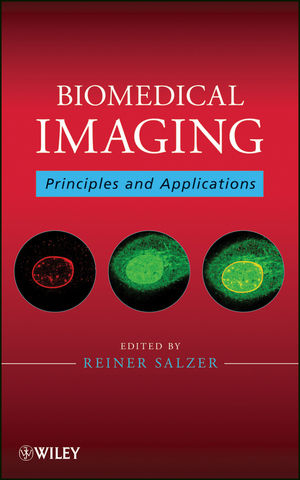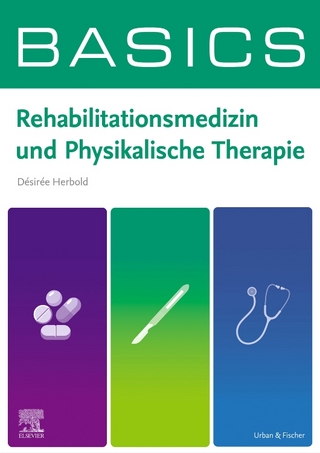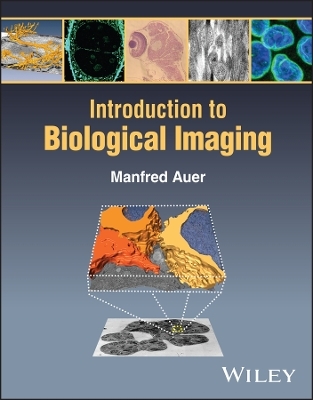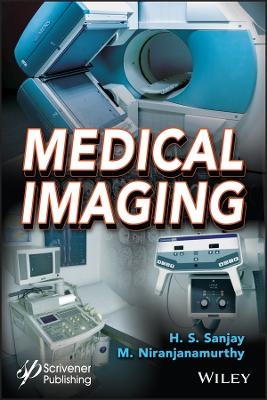
Biomedical Imaging
John Wiley & Sons Inc (Verlag)
978-0-470-64847-6 (ISBN)
REINER SALZER, PHD, is a professor at the Institute for Analytical Chemistry at Technische Universität in Dresden, Germany.
Preface xv
Contributors xvii
1 Evaluation of Spectroscopic Images 1
Patrick W.T. Krooshof, Geert J. Postma, Willem J. Melssen, and Lutgarde M.C. Buydens
1.1 Introduction 1
1.2 Data Analysis 2
1.2.1 Similarity Measures 3
1.2.2 Unsupervised Pattern Recognition 4
1.2.2.1 Partitional Clustering 4
1.2.2.2 Hierarchical Clustering 6
1.2.2.3 Density-Based Clustering 7
1.2.3 Supervised Pattern Recognition 9
1.2.3.1 Probability of Class Membership 9
1.3 Applications 11
1.3.1 Brain Tumor Diagnosis 11
1.3.2 MRS Data Processing 12
1.3.2.1 Removing MRS Artifacts 12
1.3.2.2 MRS Data Quantitation 13
1.3.3 MRI Data Processing 14
1.3.3.1 Image Registration 15
1.3.4 Combining MRI and MRS Data 16
1.3.4.1 Reference Data Set 16
1.3.5 Probability of Class Memberships 17
1.3.6 Class Membership of Individual Voxels 18
1.3.7 Classification of Individual Voxels 20
1.3.8 Clustering into Segments 22
1.3.9 Classification of Segments 23
1.3.10 Future Directions 24
References 25
2 Evaluation of Tomographic Data 30
Jorg van den Hoff
2.1 Introduction 30
2.2 Image Reconstruction 33
2.3 Image Data Representation: Pixel Size and Image Resolution 34
2.4 Consequences of Limited Spatial Resolution 39
2.5 Tomographic Data Evaluation: Tasks 46
2.5.1 Software Tools 46
2.5.2 Data Access 47
2.5.3 Image Processing 47
2.5.3.1 Slice Averaging 48
2.5.3.2 Image Smoothing 48
2.5.3.3 Coregistration and Resampling 51
2.5.4 Visualization 52
2.5.4.1 Maximum Intensity Projection (MIP) 52
2.5.4.2 Volume Rendering and Segmentation 54
2.5.5 Dynamic Tomographic Data 56
2.5.5.1 Parametric Imaging 57
2.5.5.2 Compartment Modeling of Tomographic Data 57
2.6 Summary 61
References 61
3 X-Ray Imaging 63
Volker Hietschold
3.1 Basics 63
3.1.1 History 63
3.1.2 Basic Physics 64
3.2 Instrumentation 66
3.2.1 Components 66
3.2.1.1 Beam Generation 66
3.2.1.2 Reduction of Scattered Radiation 67
3.2.1.3 Image Detection 69
3.3 Clinical Applications 76
3.3.1 Diagnostic Devices 76
3.3.1.1 Projection Radiography 76
3.3.1.2 Mammography 78
3.3.1.3 Fluoroscopy 81
3.3.1.4 Angiography 82
3.3.1.5 Portable Devices 84
3.3.2 High Voltage and Image Quality 85
3.3.3 Tomography/Tomosynthesis 87
3.3.4 Dual Energy Imaging 87
3.3.5 Computer Applications 88
3.3.6 Interventional Radiology 92
3.4 Radiation Exposure to Patients and Employees 92
References 95
4 Computed Tomography 97
Stefan Ulzheimer and Thomas Flohr
4.1 Basics 97
4.1.1 History 97
4.1.2 Basic Physics and Image Reconstruction 100
4.2 Instrumentation 102
4.2.1 Gantry 102
4.2.2 X-ray Tube and Generator 103
4.2.3 MDCT Detector Design and Slice Collimation 103
4.2.4 Data Rates and Data Transmission 107
4.2.5 Dual Source CT 107
4.3 Measurement Techniques 109
4.3.1 MDCT Sequential (Axial) Scanning 109
4.3.2 MDCT Spiral (Helical) Scanning 109
4.3.2.1 Pitch 110
4.3.2.2 Collimated and Effective Slice Width 110
4.3.2.3 Multislice Linear Interpolation and z-Filtering 111
4.3.2.4 Three-Dimensional Backprojection and Adaptive Multiple Plane Reconstruction (AMPR) 114
4.3.2.5 Double z-Sampling 114
4.3.3 ECG-Triggered and ECG-Gated Cardiovascular CT 115
4.3.3.1 Principles of ECG-Triggering and ECG-Gating 115
4.3.3.2 ECG-Gated Single-Segment and Multisegment Reconstruction 118
4.4 Applications 119
4.4.1 Clinical Applications of Computed Tomography 119
4.4.2 Radiation Dose in Typical Clinical Applications and Methods for Dose Reduction 122
4.5 Outlook 125
References 127
5 Magnetic Resonance Technology 131
Boguslaw Tomanek and Jonathan C. Sharp
5.1 Introduction 131
5.2 Magnetic Nuclei Spin in a Magnetic Field 133
5.2.1 A Pulsed rf Field Resonates with Magnetized Nuclei 135
5.2.2 The MR Signal 137
5.2.3 Spin Interactions Have Characteristic Relaxation Times 138
5.3 Image Creation 139
5.3.1 Slice Selection 139
5.3.2 The Signal Comes Back—The Spin Echo 142
5.3.3 Gradient Echo 143
5.4 Image Reconstruction 145
5.4.1 Sequence Parameters 146
5.5 Image Resolution 148
5.6 Noise in the Image—SNR 149
5.7 Image Weighting and Pulse Sequence Parameters TE and TR 150
5.7.1 T2-Weighted Imaging 150
5.7.2 T∗2 -Weighted Imaging 151
5.7.3 Proton-Density-Weighted Imaging 152
5.7.4 T1-Weighted Imaging 152
5.8 A Menagerie of Pulse Sequences 152
5.8.1 EPI 154
5.8.2 FSE 154
5.8.3 Inversion-Recovery 155
5.8.4 DWI 156
5.8.5 MRA 158
5.8.6 Perfusion 159
5.9 Enhanced Diagnostic Capabilities of MRI—Contrast Agents 159
5.10 Molecular MRI 159
5.11 Reading the Mind—Functional MRI 160
5.12 Magnetic Resonance Spectroscopy 161
5.12.1 Single Voxel Spectroscopy 163
5.12.2 Spectroscopic Imaging 163
5.13 MR Hardware 164
5.13.1 Magnets 164
5.13.2 Shimming 167
5.13.3 Rf Shielding 168
5.13.4 Gradient System 168
5.13.5 MR Electronics—The Console 169
5.13.6 Rf Coils 170
5.14 MRI Safety 171
5.14.1 Magnet Safety 171
5.14.2 Gradient Safety 173
5.15 Imaging Artefacts in MRI 173
5.15.1 High Field Effects 174
5.16 Advanced MR Technology and Its Possible Future 175
References 175
6 Toward A 3D View of Cellular Architecture: Correlative Light Microscopy and Electron Tomography 180
Jack A. Valentijn, Linda F. van Driel, Karen A. Jansen, Karine M. Valentijn, and Abraham J. Koster
6.1 Introduction 180
6.2 Historical Perspective 181
6.3 Stains for CLEM 182
6.4 Probes for CLEM 183
6.4.1 Probes to Detect Exogenous Proteins 183
6.4.1.1 Green Fluorescent Protein 183
6.4.1.2 Tetracysteine Tags 186
6.4.1.3 Theme Variations: Split GFP and GFP-4C 187
6.4.2 Probes to Detect Endogenous Proteins 188
6.4.2.1 Antifluorochrome Antibodies 189
6.4.2.2 Combined Fluorescent and Gold Probes 189
6.4.2.3 Quantum Dots 190
6.4.2.4 Dendrimers 191
6.4.3 Probes to Detect Nonproteinaceous Molecules 192
6.5 CLEM Applications 193
6.5.1 Diagnostic Electron Microscopy 193
6.5.2 Ultrastructural Neuroanatomy 194
6.5.3 Live-Cell Imaging 196
6.5.4 Electron Tomography 197
6.5.5 Cryoelectron Microscopy 198
6.5.6 Immuno Electron Microscopy 201
6.6 Future Perspective 202
References 205
7 Tracer Imaging 215
Rainer Hinz
7.1 Introduction 215
7.2 Instrumentation 216
7.2.1 Radioisotope Production 216
7.2.2 Radiochemistry and Radiopharmacy 219
7.2.3 Imaging Devices 220
7.2.4 Peripheral Detectors and Bioanalysis 225
7.3 Measurement Techniques 228
7.3.1 Tomographic Image Reconstruction 228
7.3.2 Quantification Methods 229
7.3.2.1 The Flow Model 230
7.3.2.2 The Irreversible Model for Deoxyglucose 230
7.3.2.3 The Neuroreceptor Binding Model 233
7.4 Applications 234
7.4.1 Neuroscience 234
7.4.1.1 Cerebral Blood Flow 234
7.4.1.2 Neurotransmitter Systems 235
7.4.1.3 Metabolic and Other Processes 238
7.4.2 Cardiology 240
7.4.3 Oncology 240
7.4.3.1 Angiogenesis 240
7.4.3.2 Proliferation 241
7.4.3.3 Hypoxia 241
7.4.3.4 Apoptosis 242
7.4.3.5 Receptor Imaging 242
7.4.3.6 Imaging Gene Therapy 243
7.4.4 Molecular Imaging for Research in Drug Development 243
7.4.5 Small Animal Imaging 244
References 244
8 Fluorescence Imaging 248
Nikolaos C. Deliolanis, Christian P. Schultz, and Vasilis Ntziachristos
8.1 Introduction 248
8.2 Contrast Mechanisms 249
8.2.1 Endogenous Contrast 249
8.2.2 Exogenous Contrast 251
8.3 Direct Methods: Fluorescent Probes 251
8.4 Indirect Methods: Fluorescent Proteins 252
8.5 Microscopy 253
8.5.1 Optical Microscopy 253
8.5.2 Fluorescence Microscopy 254
8.6 Macroscopic Imaging/Tomography 260
8.7 Planar Imaging 260
8.8 Tomography 262
8.8.1 Diffuse Optical Tomography 266
8.8.2 Fluorescence Tomography 266
8.9 Conclusion 267
References 268
9 Infrared and Raman Spectroscopic Imaging 275
Gerald Steiner
9.1 Introduction 275
9.2 Instrumentation 278
9.2.1 Infrared Imaging 278
9.2.2 Near-Infrared Imaging 281
9.3 Raman Imaging 282
9.4 Sampling Techniques 283
9.5 Data Analysis and Image Evaluation 285
9.5.1 Data Preprocessing 287
9.5.2 Feature Selection 287
9.5.3 Spectral Classification 288
9.5.4 Image Processing Including Pattern Recognition 292
9.6 Applications 292
9.6.1 Single Cells 292
9.6.2 Tissue Sections 292
9.6.2.1 Brain Tissue 294
9.6.2.2 Skin Tissue 295
9.6.2.3 Breast Tissue 298
9.6.2.4 Bone Tissue 299
9.6.3 Diagnosis of Hemodynamics 300
References 301
10 Coherent Anti-Stokes Raman Scattering Microscopy 304
Annika Enejder, Christoph Heinrich, Christian Brackmann, Stefan Bernet, and Monika Ritsch-Marte
10.1 Basics 304
10.1.1 Introduction 304
10.2 Theory 306
10.3 CARS Microscopy in Practice 309
10.4 Instrumentation 310
10.5 Laser Sources 311
10.6 Data Acquisition 314
10.7 Measurement Techniques 316
10.7.1 Excitation Geometry 316
10.7.2 Detection Geometry 318
10.7.3 Time-Resolved Detection 319
10.7.4 Phase-Sensitive Detection 319
10.7.5 Amplitude-Modulated Detection 320
10.8 Applications 320
10.8.1 Imaging of Biological Membranes 321
10.8.2 Studies of Functional Nutrients 321
10.8.3 Lipid Dynamics and Metabolism in Living Cells and Organisms 322
10.8.4 Cell Hydrodynamics 324
10.8.5 Tumor Cells 325
10.8.6 Tissue Imaging 325
10.8.7 Imaging of Proteins and DNA 326
10.9 Conclusions 326
References 327
11 Biomedical Sonography 331
Georg Schmitz
11.1 Basic Principles 331
11.1.1 Introduction 331
11.1.2 Ultrasonic Wave Propagation in Biological Tissues 332
11.1.3 Diffraction and Radiation of Sound 333
11.1.4 Acoustic Scattering 337
11.1.5 Acoustic Losses 338
11.1.6 Doppler Effect 339
11.1.7 Nonlinear Wave Propagation 339
11.1.8 Biological Effects of Ultrasound 340
11.1.8.1 Thermal Effects 340
11.1.8.2 Cavitation Effects 340
11.2 Instrumentation of Real-Time Ultrasound Imaging 341
11.2.1 Pulse-Echo Imaging Principle 341
11.2.2 Ultrasonic Transducers 342
11.2.3 Beamforming 344
11.2.3.1 Beamforming Electronics 344
11.2.3.2 Array Beamforming 345
11.3 Measurement Techniques of Real-Time Ultrasound Imaging 347
11.3.1 Doppler Measurement Techniques 347
11.3.1.1 Continuous Wave Doppler 347
11.3.1.2 Pulsed Wave Doppler 349
11.3.1.3 Color Doppler Imaging and Power Doppler Imaging 351
11.3.2 Ultrasound Contrast Agents and Nonlinear Imaging 353
11.3.2.1 Ultrasound Contrast Media 353
11.3.2.2 Harmonic Imaging Techniques 356
11.3.2.3 Perfusion Imaging Techniques 357
11.3.2.4 Targeted Imaging 358
11.4 Application Examples of Biomedical Sonography 359
11.4.1 B-Mode, M-Mode, and 3D Imaging 359
11.4.2 Flow and Perfusion Imaging 362
References 365
12 Acoustic Microscopy for Biomedical Applications 368
Jurgen Bereiter-Hahn
12.1 Sound Waves and Basics of Acoustic Microscopy 368
12.1.1 Propagation of Sound Waves 369
12.1.2 Main Applications of Acoustic Microscopy 371
12.1.3 Parameters to Be Determined and General Introduction into Microscopy with Ultrasound 371
12.2 Types of Acoustic Microscopy 372
12.2.1 Scanning Laser Acoustic Microscope (LSAM) 373
12.2.2 Pulse-Echo Mode: Reflection-Based Acoustic Microscopy 373
12.2.2.1 Reflected Amplitude Measurements 379
12.2.2.2 V(z) Imaging 380
12.2.2.3 V(f) Imaging 382
12.2.2.4 Interference-Fringe-Based Image Analysis 383
12.2.2.5 Determination of Phase and the Complex Amplitude 386
12.2.2.6 Combining V (f) with Reflected Amplitude and Phase Imaging 386
12.2.2.7 Time-Resolved SAM and Full Signal Analysis 388
12.3 Biomedical Applications of Acoustic Microscopy 391
12.3.1 Influence of Fixation on Acoustic Parameters of Cells and Tissues 391
12.3.2 Acoustic Microscopy of Cells in Culture 392
12.3.3 Technical Requirements 393
12.3.3.1 Mechanical Stability 393
12.3.3.2 Frequency 393
12.3.3.3 Coupling Fluid 393
12.3.3.4 Time of Image Acquisition 394
12.3.4 What Is Revealed by SAM: Interpretation of SAM Images 394
12.3.4.1 Sound Velocity, Elasticity, and the Cytoskeleton 395
12.3.4.2 Attenuation 400
12.3.4.3 Viewing Subcellular Structures 401
12.3.5 Conclusions 401
12.4 Examples of Tissue Investigations using SAM 403
12.4.1 Hard Tissues 404
12.4.2 Cardiovascular Tissues 405
12.4.3 Other Soft Tissues 406
References 406
| Verlagsort | New York |
|---|---|
| Sprache | englisch |
| Maße | 158 x 236 mm |
| Gewicht | 862 g |
| Themenwelt | Medizin / Pharmazie ► Medizinische Fachgebiete ► Radiologie / Bildgebende Verfahren |
| Medizin / Pharmazie ► Physiotherapie / Ergotherapie ► Orthopädie | |
| Technik ► Medizintechnik | |
| ISBN-10 | 0-470-64847-3 / 0470648473 |
| ISBN-13 | 978-0-470-64847-6 / 9780470648476 |
| Zustand | Neuware |
| Informationen gemäß Produktsicherheitsverordnung (GPSR) | |
| Haben Sie eine Frage zum Produkt? |
aus dem Bereich


